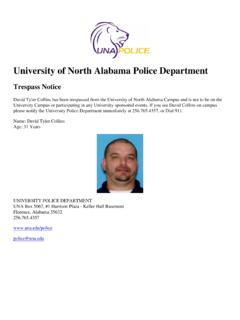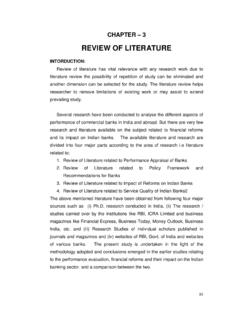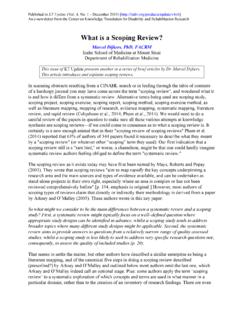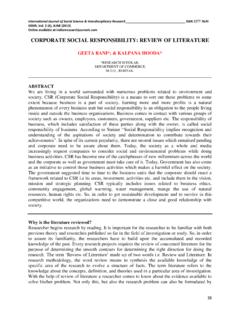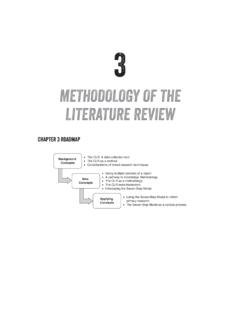Transcription of INTRODUCTION TO LITERATURE REVIEWS
1 INTRODUCTION TO LITERATURE REVIEWS Amber Huett, David MacMillan, Katie Crum, and Dr. R. T. Koch July 2011 UNA Center for Writing Excellence 1 The idea of LITERATURE usually conjures up images of dusty books that you are required to read for English, American, or World LITERATURE classes. The LITERATURE in a LITERATURE review , however, refers to all the previous research and scholarship on a particular topic, no matter what discipline you are studying; the review is your explanation of what the LITERATURE says.
2 A LITERATURE review is the synthesis of the available LITERATURE regarding your research topic. This synthesis merges the conclusions of many different sources to explain the overall understanding of the topic, thus laying a foundation for both the research question and primary research. Although a LITERATURE review will cite sources and should discuss the credibility of the sources included, it is more than an annotated bibliography. Your LITERATURE review needs to review all the significant sources on a topic, regardless of whether or not they support the claims you will eventually be working toward.
3 Your LITERATURE review , like any other document, should contain an INTRODUCTION , a body, and a conclusion. INTRODUCTION Your INTRODUCTION should clearly explain the overall research topic and the depth of the information to be presented; it often also explains the types of sources that will be used. If your LITERATURE review is part of a larger research proposal or project, its INTRODUCTION can be combined with the INTRODUCTION of your paper. Body The body of your LITERATURE review is intended to give your audience an overview of the already-available research on your topic.
4 This can serve several purposes, including: Establishing your credibility as an informed researcher Illustrating the importance of a particular problem in a field Identifying a gap in the knowledge of a particular subject Defining key terms and ideas that are used in a particular field Explaining research methods commonly used in a discipline Identifying potential problems with possible research methods Directing the reader toward the research question Unlike the body of an essay or research paper.
5 The body of a LITERATURE review is not intended to directly support a thesis, unless this approach is specifically assigned. Instead, it provides the reader with the background information needed before moving into further study or research. Generally speaking, the overall purpose of a LITERATURE review is to establish a framework for further discussion. Present each piece of LITERATURE using a claim, evidence, and discussion, but explain general information rather than arguing specifically in support of your thesis.
6 1. The claim needs to tie into the overall purpose that the LITERATURE review relays. This may tie into one of the modes of thought, such as comparison and contrast or cause and effect. 2. The evidence needs to be properly cited information from reliable sources that are relevant to the topic and consists of the information given within the sources that you are reviewing. 3. The discussion needs to show how the sources support the specific claim being made. The discussion should also put the information into a context that reflects your intended purpose.
7 A LITERATURE review should not simply list the relevant sources; that is the purpose of an annotated bibliography. Coherent structure is important. The general information needs to work toward some overall framework. Outlining the sources that you will present can help to provide a structure that will direct your audience toward the research topic. LITERATURE REVIEWS Amber Huett, David MacMillan, Katie Crum, and Dr. R. T. Koch July 2011 UNA Center for Writing Excellence 2 Conclusion Depending on the purpose(s) of your LITERATURE review , your conclusion may include the following: INTRODUCTION to further research: The conclusion of your LITERATURE review can be used to explain your intended research question.
8 Summary of theories: Your conclusion can summarize central theories and ideas that give your reader a better understanding of the topic. Discussion of the gap: If your LITERATURE review has revealed a gap in general understanding, your conclusion can explain the significance of that gap. Regardless of what your LITERATURE review includes, it will always explain what you learned and how this affects your understanding of the various problems or questions within the field. A conclusion should not spend time reiterating the sources already discussed; most of it should focus on presenting the general consensus gleaned from the sources provided.
9 Organizing the sources in the body of a LITERATURE review Organizing a LITERATURE review requires you to order your sources according to a progression of ideas and content. Usually, good organization will follow one or more of the patterns of the Modes of Thought, the ways of writing and organizing your paper: Comparison and Contrast Cause and Effect Problem and Solution Process Description Illustration Classification Division Narrative Do any of your sources discuss causes or effects?
10 Do they reveal problems in a field or list solutions? Do they provide illustrations of the topic? Do they define complex theories or ideas? Depending on the way you choose to organize your review , you may end up using different sources multiple times. It can often be useful to create an outline that contains the plan for organizing your sources before you begin writing. Most strategies for outlining essays or research papers will work just as well for LITERATURE REVIEWS . review what each of your sources say about the issues that the LITERATURE review is exploring.







